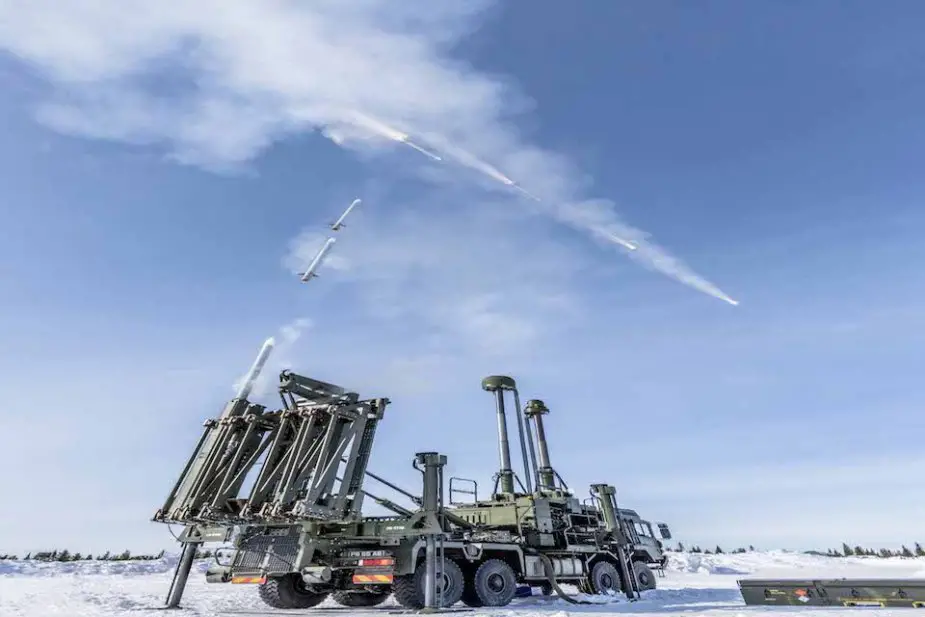Breaking news
Successful test firing of British new Land Ceptor air defence missile.
A brand-new missile system at the heart of the British Army’s future air defences has completed its first successful firing trials, Defence Secretary Gavin Williamson has announced. The trial, which followed previous munitions tests, was the first time Land Ceptor had been test-fired as a whole system, including the cutting-edge SAAB Giraffe radar.

Built by MBDA, Land Ceptor comprises the Common Anti-air Modular Missile (CAMM), a launcher vehicle and two fire unit support vehicles. (Crown copyright)
Trials of the new Land Ceptor weapon took place close to the Baltic Sea on a Swedish test fire range, with video footage showing a missile being launched from a vehicle and destroying an aerial target in a display of the new weapon’s accuracy and power. Land Ceptor comprises the Common Anti-air Modular Missile (CAMM), a launcher vehicle and two fire unit support vehicles. It is being developed to protect British troops on operations from aerial threats, including hostile combat aircraft and air-launched munitions. Land Ceptor will be brought into service by the British Army as a replacement for the Rapier air defence system.
Land Ceptor has far greater battlefield awareness and intelligence than the current Rapier system as its engagement range is three times greater and the Giraffe radar and Rafael Battlespace Management Command, Control, Compute, Communicate and Inform (BMC4I) system within Sky Sabre will be able to observe incoming threats from seven times further away. The missiles can be launched in quick succession to defeat as many as eight different threats at once, even if obstacles such as trees and terrain are in the way. Land Ceptor is highly mobile, can be rapidly deployed across challenging terrain, and be brought into action in less than 20 minutes.
The CAMM (Common Anti-Air Modular Missile) series is a family of surface-to-air and air-to-air missiles developed by MBDA for the United Kingdom. The common missile will meet the future anti-air target requirements of navies, armies and air forces. Given that the target set, ranging from fast jets and helicopters to cruise missiles and UAVs, is similar across the sea, land and air domains, a weapon solution maximizing modularity and commonality has obvious cost and logistics benefits. The CAMM will provide future land forces with an easily transportable and rapidly deployable local area air defence capability, which can operate as a stand-alone unit or be integrated within a future battle-space network. If 3rd party targeting information is available via the battle-space network, then CAMM is capable of engaging Non-Line of Sight (NLOS) targets. This NLOS feature is particularly attractive for engaging concealed attack helicopters and low-flying terrain-following cruise missiles. The CAMM Land variant was ordered by United Kingdom to replace the Rapier. The Soft Vertical Launch was proven over a series of trials, culminating in a successful truck launch in May 2011. In May 2014, the British MOD has ordered the Land variant of the Future Local Area Air Defence System (FLAADS Land), the CAMM. FLAADS is part of a wider UK 'Complex Weapons' programme to deliver a variety of UK industry based weapons. FLAADS is intended to deliver a common weapons platform (the Common Anti-Air Modular Missile (CAMM)) to equip forces in the air, land a maritime environments.
From the same family of weapons systems as Sea Ceptor, which will defend the Royal Navy’s Type 23 and Type 26 Frigates, Land Ceptor will provide the stopping power within the cutting-edge Sky Sabre air defence system, and will equip 16th Regiment, Royal Artillery.
The success of the Land Ceptor trials follows the Defence Secretary’s recent announcement of Sea Ceptor entering service with the Royal Navy proves CAMM’s effectiveness both in the land and maritime environments.
The development and manufacture of Land Ceptor is enabled through a £250 million contract between Defence Equipment and Support (DE&S) and MBDA. Work to develop both Land Ceptor and Sea Ceptor is sustaining 760 MBDA jobs in the UK.
DE&S Director Weapons, Richard Smart, said: “This trials firing is an important stepping stone towards bringing Land Ceptor into service with the British Army as part of the wider Sky Sabre air defence system. Land Ceptor performed as expected and the firing has helped us to verify innovative modelling of overall system performance. The DE&S project team, based in Bristol, will continue to work closely with our suppliers to ensure this cutting-edge system provides an effective shield for UK troops as they, in turn, protect the UK’s security and interests”.
Land Ceptor has far greater battlefield awareness and intelligence than the current Rapier system as its engagement range is three times greater and the Giraffe radar and Rafael Battlespace Management Command, Control, Compute, Communicate and Inform (BMC4I) system within Sky Sabre will be able to observe incoming threats from seven times further away. The missiles can be launched in quick succession to defeat as many as eight different threats at once, even if obstacles such as trees and terrain are in the way.
The system will now undergo further development and trials before Sky Sabre enters service, in the early 2020s.


























